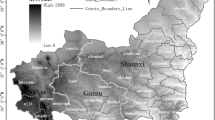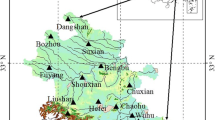Abstract
To understand the mechanisms underlying the effects of climate variation, especially the effects of water on vegetation, vegetation type and distribution as well as climate data and soil type were used to simulate present vegetation distributions and net primary productivity (NPP) under present and future climate scenarios SRES-A2 and SRES-B2. A natural vegetation NPP model was also applied to calculate future vegetation NPP. The results showed that water played a dominant role not only in the distribution of vegetation, but also in the rate of change in the vegetation area. Analysis of NPP showed that precipitation had more effects on the amount of biome NPP than temperature did. Different effects were observed for the rate of change in NPP. In cases where biomes remain unaltered, the variation in annual precipitation could account for 39% of the variation in NPP. In cases where biomes changed, 45% of NPP was caused by temperature variation. Regarding the variation in transect production, −2.85% resulted from the change in vegetation structure when compared with present NPP, and 7.69% from the climate change under scenario SRES-B2; these values were −7.4 and 19.56%, respectively, under scenario SRES-A2. The results showed water served as a dominant factor controlling the vegetation distributions and NPP. However, temperature became determinant where the biomes changed, impacting the rate of change in vegetation NPP when the climate changed. The results also showed that water would have a positive effect on transect production, and the structure of vegetation had a negative effect under the projected future climate.





Similar content being viewed by others
References
Aerts R, Cornelissen JHC, Dorrepaal E (2006) Plant performance in a warmer world: general responses of plants from cold, northern biomes and the importance of winter and spring events. Plant Ecol 182:65–77
Canadell JG, Steffen WL, White PS (2002) IGBP/GCTE terrestrial transects: dynamics of terrestrial ecosystems under environmental change. J Veg Sci 13:298–300
Cao MK, Prince SD, Li KR (2003) Response of terrestrial carbon uptake to climate interannual variability in China. Global Change Biol 9(4):536–546
Chapin FS III, Matson PA, Mooney HA (2002) Principles of terrestrial ecosystem ecology. Springer, New York, pp 127–132
Christensen JH, Christensen OB (2003) Severe summertime flooding in Europe. Nature 421:805–806
Ding YH, Ren GY, Shi GY, Gong P, Zheng XH, Zhai PM, Zhang DE, Zhao ZC, Wang SW, Wang HJ, Luo Y, Chen DL, Gao XJ, Dai XS (2006) National assessment report of climate change (I): climate change in China and its future trend. Adv Climate Change Res 2(1):3–8
Fuhrer J, Beniston M, Fischlin A, Frei C, Goyette S, Jasper K, Pfister C (2006) Climate risks and their impact on agriculture and forests in Switzerland. Clim Change 79:79–102
Gao XJ, Ding YH, Zhao ZC, Hang RH (2003a) Climate change due to greenhouse effects in China as simulated by a regional climate model part I: evaluation of the model simulations. Acta Meteorol Sin 61:20–28
Gao XJ, Ding YH, Zhao ZC, Hang RH (2003b) Climate change due to greenhouse effects in China as simulated by a regional climate model part II, climate change. Acta Meteorol Sin 61:29–38
GCTE–IPC (1994) GCTE Core Research: 1993 Annual Report No. 1. Canberra, p 135
Grime JP, Brown VK, Thompson K, Masters GJ, Hillier SH, Clarke IP, Askew AP, Corker D, Kielty JP (2000) The response of two contrasting limestone grasslands to simulated climate change. Science 289:762–765
Hou XY (1982) Vegetation map of People’s Republic of China. Map Press, Beijing, p 65
IPCC (2001) Climate change 2001: the scientific basis. Cambridge University Press, Cambridge
ISSCAS (1978) Soils of China. Science Press, Beijing, p 60
Jiang GM, Tang HP, Yu M, Dong M, Zhang XS (1999) Response of photosynthesis of different plant functional types to environmental changes along Northeast China Transect. Trees 14:72–82
Knapp AK, Fay PA, Blair JM, Collins SL, Smith MD, Carlisle JD, Harper CW, Danner BT, Lett MS, McCarron JK (2002) Rainfall variability, carbon cycling, and plant species diversity in a mesic grassland. Science 298:2202–2205
Koch GW, Scholes RJ, Steffen WL, Vitousek PM, Walker BH (1995) The IGBP terrestrial transects: science plan. International biosphere–geosphere programmme (IGBP) report 36. Stockholm, Sweden, pp 130–141
Leeman R (1997) The use of plant functional type classifications to model global land cover and simulate the interactions between the terrestrial biosphere and atmosphere. In: Smith TM, Shugart HH, Woodward FI (eds) Plant functional types—their relevance to ecosystem properties and global change. Cambridge University Press, London, pp 289–316
Li XR, Ma FY, Xiao HL, Wang XP, Kim KC (2004) Long-term effects of revegetation on soil water content of sand dunes in arid region of Northern China. J Arid Environ 57:1–6
Melillo JM, Borchere J, Chaney J (1995) Vegetation/ecosystem modeling and analysis project comparing biogeography and biochemistry models in a continental-scale study of terrestrial ecosystem responses to climate change and CO2 doubling. Global Biogeochem Cycle 40:407–437
Ni J (2001) A biome classification of China based on plant functional types and the BIOME3 model. Folia Geobot 36:113–129
Ni J (2003) Plant functional types and climate along a precipitation gradient in temperate grasslands, Northeast China and Southeast Mongolia. J Arid Environ 53:501–516
Osumi K, Ikeda S, Okamoto T (2003) Vegetation patterns and their dependency on site conditions in the pre–industrial landscape of northern-eastern Japan. Ecol Res 18:753–765
Pan YD, Melillo JM, Kicklighter DW, Xiao XP, Mcguire AD (2001) Modeling structural and functional responses of terrestrial ecosystems in China to changes in climate and atmospheric CO2. Acta Bot Sin 25(2):175–189
Peng SL, Zhao P, Ren H (2002) The possible heat-driven pattern variation of zonal vegetation and agricultural ecosystems along the North–South Transect of China under the global change. Earth Sci Front 9(1):217–226
Schwinning S, Sala OE (2004) Hierarchy of responses to resource pulses in arid and semi–arid ecosystems. Oecologia 141:211–220
Steffen WL, Scholes RJ, Valentin C, Zhang XS, Menaut JC (1999) The IGBP terrestrial transects. In: Walker BH, Steffen WL, Canadell J, Ingram JSI (eds) The terrestrial biosphere and global change: implications for natural and managed ecosystems. Cambridge University Press, London, pp 66–87
Svejcar T, Angell R, Miller R (1999) Fixed location rain shelters for studying precipitation effects on rangelands. J Arid Environ 42:187–193
Valleron AJ, Boumendil A (2004) Epidemiology and heat waves: analysis of the 2003 episode in France. C R Biol 327:1125–1141
Wang RZ (2002) Photosynthetic pathways and life forms in different grassland types from North China. Photosynthetica 40:243–250
Wang RZ, Gao Q (2003) Climate-driven changes in shoot density and shoot biomass in Leymus chinensis (Poaceae) on the north-east China Transect (NSTEC). Global Ecol Biogeogr 12:249–259
Wang YH, Zhou GS (2000) Analysis and quantitative simulation of stomatal conductance of Aneurolepidium Chinense. Acta Phytoecol Sin 24(6):739–743
Wang YH, Zhou GS (2001) Analysis on ecophysiological characteristics of leaf photosynthesis of Aneurolepidium chinense in songnen grassland. Chin J Appl Ecol 12(1):75–79
Wang RZ, Gao Q, Chen QS (2003) Effects of climatic change on biomass allocation in Leymus chinensis (Poaceae) along the Northeast China Transect (NECT). J Arid Environ 54:653–665
Weng ES, Zhou GS (2005) Defining plant functional types in China for global change studies. Acta Bot Sin 29(1):81–97
Weng ES, Zhou GS (2006) Modeling distribution changes in vegetation in China under climate change. Environ Model Assess 11(1):45–58
Woodward FI (1987) Climate and plant distribution. Cambridge University Press, London
Woodward FI, McKee IF (1991) Vegetation and climate. Environ Int 17:535–546
Wu ZY (1980) China vegetation. Science Press, Beijing, p 50
Yates DN, Kittel TF, Cannon RF (2000) Comparing the correlative Holdridge models to mechanistic biogeographical models for assessing vegetation distribution response to climatic change. Clim Change 44:59–87
Yin HJ, Liu Q, Lai T (2008) Warming effects on growth and physiology in the seedlings of the conifers Picea asperata and Abies faxoniana under two contrasting light conditions. Ecol Res 23:459–469
Yu M, Gao Q, Liu YH, Xu HM, Shi PJ (2002) Responses of vegetation structure and primary production of a forest transect in eastern China to global change. Global Ecol Biogeogr 11:223–236
Zhou GS, Zhang XS (1995) Primary study on net primary production of natural vegetation. Acta Bot Sin 39(9):785–799
Zhou GS, Wang YH, Jiang YL (2002) Global change and water–driven IGBP–NECT, northeast China. Earth Sci Front 9(1):198–215
Acknowledgments
This research was jointly supported by State Key Development Program of Basic Research (2010CB951303) and the CAS’ knowledge innovative items KZCX2-SW-133. The authors would like to thank the staff from the research group for their constructive advice on the research and writing of this paper.
Author information
Authors and Affiliations
Corresponding author
Rights and permissions
About this article
Cite this article
Zhang, Y., Zhou, G. Exploring the effects of water on vegetation change and net primary productivity along the IGBP Northeast China Transect. Environ Earth Sci 62, 1481–1490 (2011). https://doi.org/10.1007/s12665-010-0632-1
Received:
Accepted:
Published:
Issue Date:
DOI: https://doi.org/10.1007/s12665-010-0632-1




